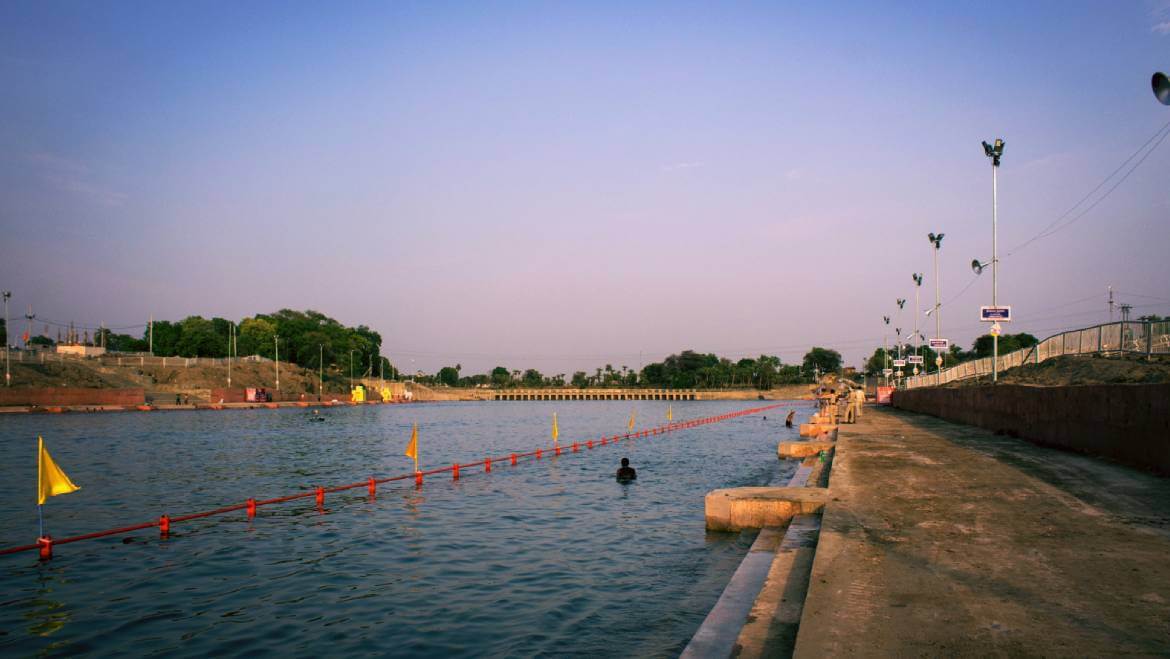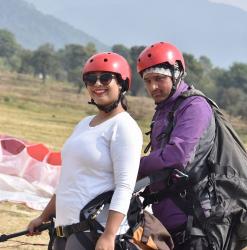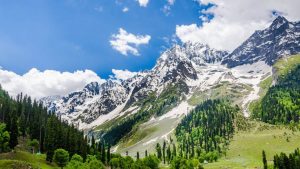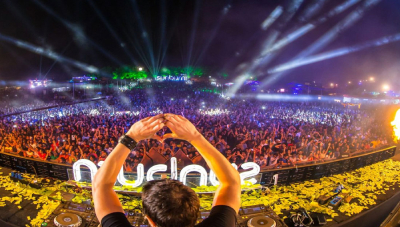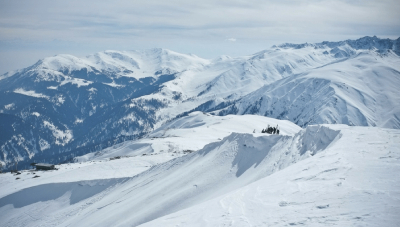1. Shree Mahakaleshwar Temple
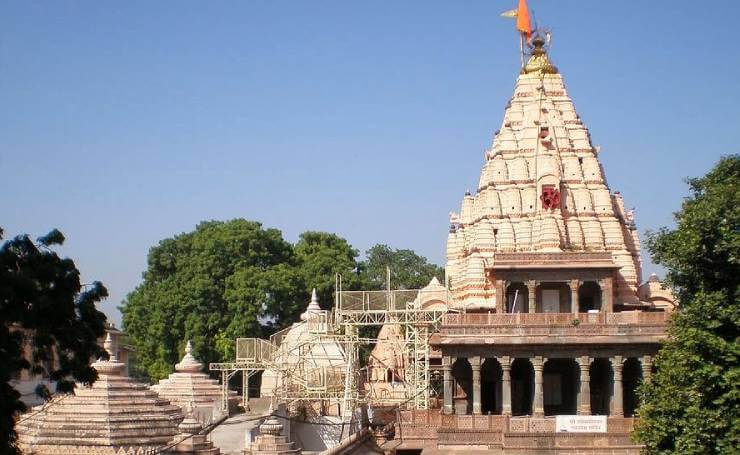
Mahakaleshwar Jyotirlinga Temple is one of the most famous Hindu temples that is dedicated to Lord Shiva and as a fact it is one of the twelve Jyotirlingas, which are said to be Shiva’s most holy abode. In several Puranas, the magnificence of the Mahakaleshwar temple is depicted. Numerous Sanskrit writers, including Kalidasa, have used emotional and appealing language to praise this shrine. Mahakala was regarded as the unique presiding god of Ujjain, which once served as the centre for calculations of Indian time.
Located in Ujjain, the temple is situated on the side of the Rudra Sagar Lake with the deity of Shiva in the lingam form also known as Swayambhu. The idol of Mahakaleshwar is known to be Dakshinamurti, which means that it faces the south, which is a unique feature among the 12 Jyotirlingas. The images of Ganesh, Parvati and Karttikeya are installed in the west, north and east of the sanctum inside the temple and the representation of Lord Shiva’s chariot, Nandi, can be seen facing south.
Shri Mahakaleshwar is the most important temple in Ujjain city as it is famous for its Bhasm Aarti. Only on the day of Nag Panchami is the idol of Nagchandreshwar on the third floor accessible for viewing. A large fair occurs next to the temple on the day of Mahashivaratri, and prayer continues all night long.
Timings: 4 AM to 11 PM
2. Kal Bhairav Temple
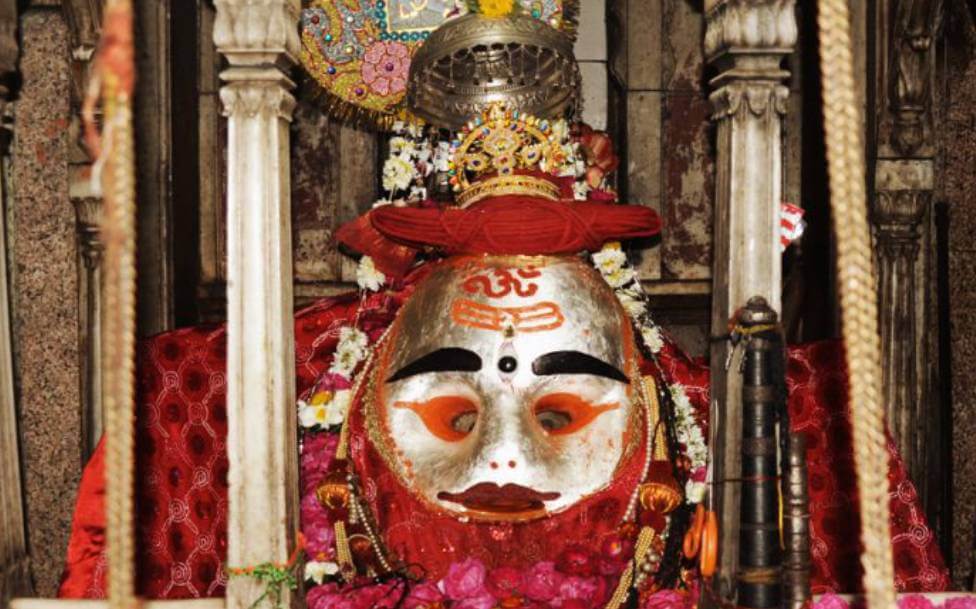
Saivite tradition includes the worship of the eight Bhairavas, the most important of which is Kal Bhairava, which is said to have been built on the banks of the Shipra by King Bhadresen. The Avanti Khanda of the Skanda Purana also provides a reference to the Kal Bhairav temple. In this temple, a Shivalinga can be found beneath a banyan tree on the outside of the temple, just across from Nandi the Bull. According to mythology, King Daksha, the father of Goddess Parvati, gave the bull to Shiva and Parvati as a wedding gift. Especially during the Mahashivratri festival, when devotees gather in large numbers around the temple, the place becomes full of life. The walls of the temple previously had stunning Malwa-style murals, but today only small traces remain. Even now liquor is still served to Kal Bhairava as part of the ritual.
The Kal Bhairava Temple is believed to be associated with the Tantra cult of Hinduism, a secret religious group that made their living through black magic. It appears that the Kapalika and Aghora groups practised the worship of Kal Bhairava. These two groups possess Ujjain as their major hub. Therefore, many sadhus with ash-smudged bodies and long matted hair can be spotted around this temple on a regular basis.
Timings: 5 AM to 7 PM
3. Jantar Mantar (Vedha Shala or Observatory)
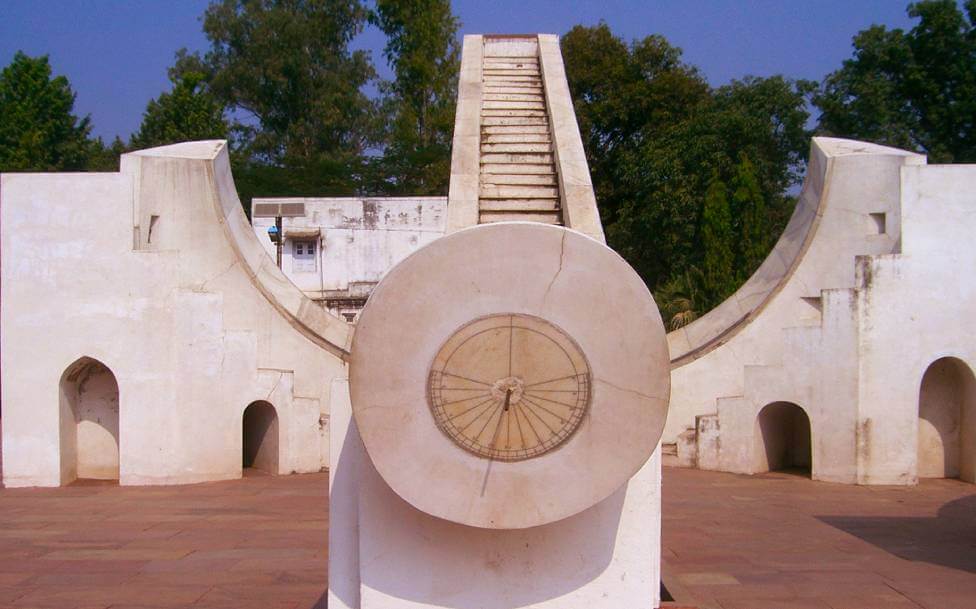
Raja Jai Singh (1686–1743), a famous scholar who translated the writings of Ptolemy and Euclid from Arabic into Sanskrit, constructed Vedh Shala, the observatory that is still in use today in Ujjain. Among the group of five observatories (Jaipur, Delhi, Ujjain, Mathura, and Varanasi), the architectural wonder Jantar Mantar, also known as the Vedh Shala Observatory, was built first and dates back to the 17th century. Raja Jaisingh created the Sun-Dial, Narivalaya, Digansha, and Transit instruments in the observatory and under the supervision of the late Shri G.S. Apte, the Shanku (Gnomon) Yantra was created.
In 2003, Miss Swarnmala Rawala, the division’s commissioner at the time, worked diligently to complete the observatory’s renovations and enhancement. The Energy Development Corporation also assisted in the installation of ten solar-powered solar tube lights, and M.P. Laghu Udyog Nigam built magnificent banks along the River Shipra near the observatory site. A robotic telescope with an 8-inch diameter was built during Simhastha in 2004 to enable people to observe planets through it. The Department of Education supervises astronomical studies, and the ephemeris is released annually. There is a very small planetarium and a telescope to observe the Moon, Mars, Jupiter and their satellites. Weather predictions are also made through the observatory.
It is also said that great works on astronomy such as the Surya Siddhanta and the Panch Siddhanta were written in Ujjain. Also, according to Indian astronomers, the Tropic of Cancer passes through Ujjain and it is also the first meridian of longitude of the Hindu geographers. Additionally, it is stated that Ujjain had the notable status of being India’s Greenwich in the fourth century BC.
Timings: 7 AM to 7 PM
Entry Fee: Indian – INR 40 | Foreigner: INR 200
4. Kaliadeh Palace
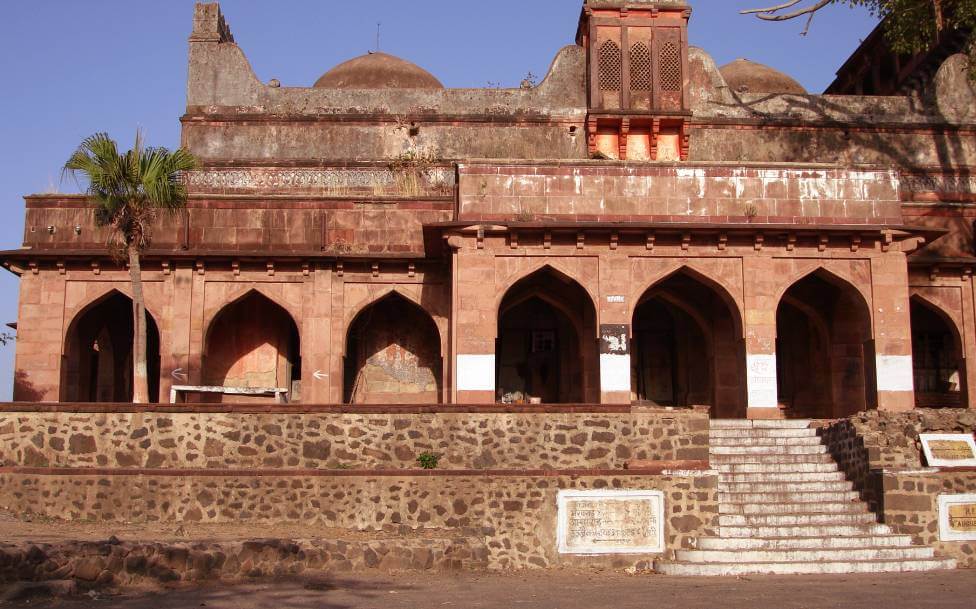
The historical palace is situated at a distance of 8 km from the town on an island in the Shipra River. The palace is a representation of the royal past and cultural significance of Ujjain. In the year 1458, Mandu Rulers built the palace. Kaliadeh Palace was built in the Persian style of architecture. During the Pindaris’ rule, it was destroyed but later was amended by Maharaja Madhav Rao Scindia I in 1920. Once, this lovely palace had also been visited by Emperors Akbar and Jehangir. River waters border the Palace on two sides, and the storage tanks and canals that were built by earlier generations are evidence of their expertise in technology. According to local legends, there was also an old Sun Temple in this location along with Surya Kunda and Brahma Kunda.
The palace is set in a very calm environment that further adds to the surrounding natural beauty. A picturesque palace surrounded by a lush garden, this is a great place for a leisurely visit and nature enthusiasts.
Timings: 9 AM to 6 PM
5. Chintaman Ganesh Temple
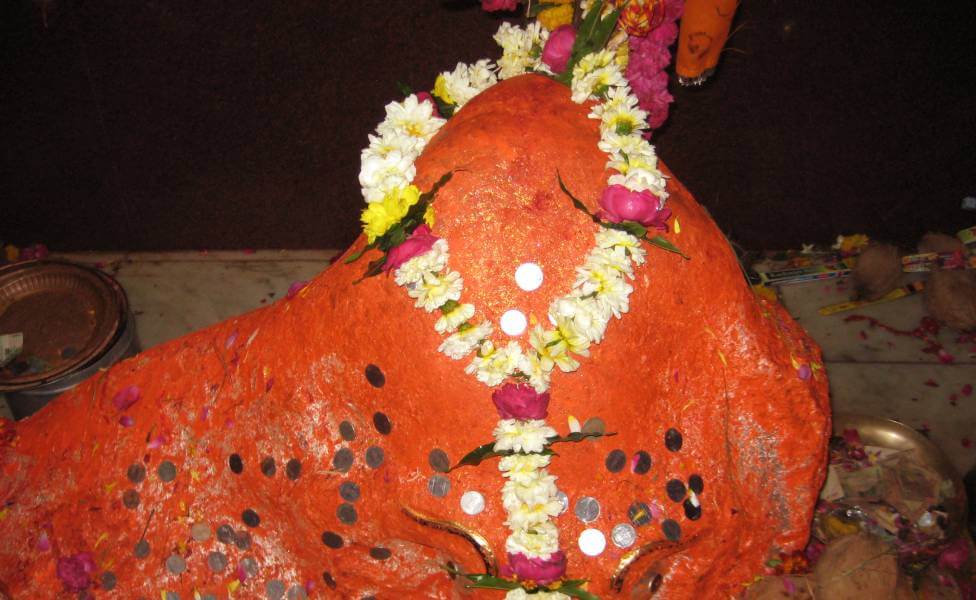
The Chintaman Ganesh Temple is situated along the Fatehabad railway line and the Shipra River. This temple is one of the most visited places in Ujjain as the Ganesh idol enshrined here is supposed to be Swayambhu (born of itself). According to mythology, Lord Ganesh himself came to earth to create this temple. Every day, a large number of worshippers attend the temple with profound devotion. The town’s market is currently just across from the temple. Due to the deity’s original name of Chintaharan Ganesh, which means “the assurer of freedom from worldly anxieties,” worshippers come to this temple to pay their homage.
The temple was built during the 11th and 12th centuries, during the Paramaras’ control over Malwa. Additionally, it is believed that Sita founded the original temple, which is said to have origins in the Ramayana period. The assembly hall’s intricately carved stone pillars and the white shrine express the temple’s long-standing sacredness.
Timings: 6 AM to 12 PM | 5 PM to 10 PM
6. Bade Ganesh Ji Ka Mandir
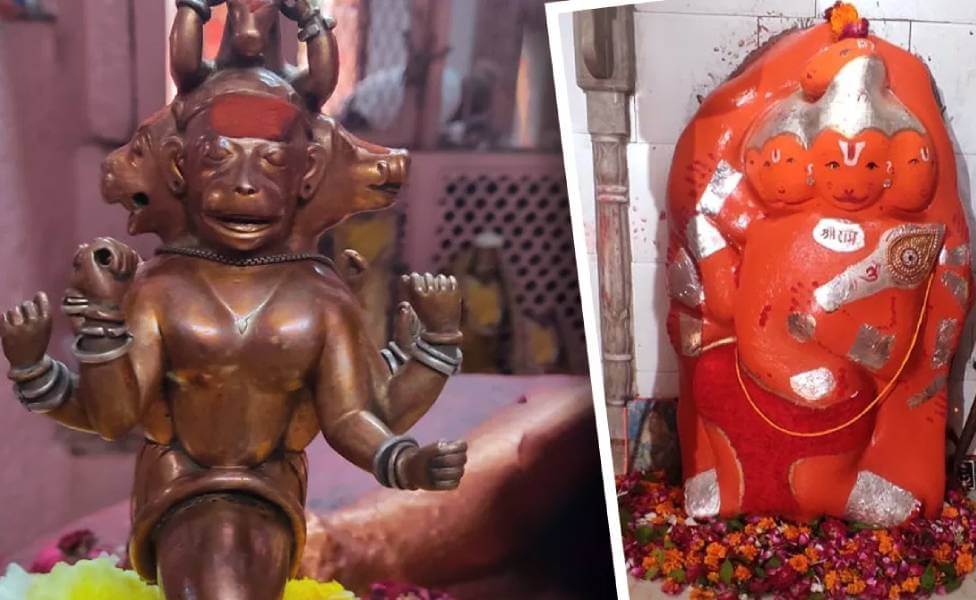
Bada Ganesh Mandir is a renowned Hindu shrine situated in Ujjain, Madhya Pradesh, 2.5 km from Ujjain Junction. Situated near the Mahakaleshwar Temple, Bade Ganeshji Ka Mandir is known for its colossal statue of the elephant-headed God. The head of the deity signifies wisdom, discretion and foresight that Hindus attribute to divinity. According to legends and folklore, Maharishi Guru Maharaj Siddhant Vagesh Pt. Narayan Ji Vyas created this Ganesh idol. The trunk of Lord Ganesh is positioned clockwise in the 18-foot-tall and 10-foot-wide Ganesh idol at the Bade Ganesh Ji ka Mandir. On the statue’s head, there’s a trident and a swastika. A Ladoo has been stuffed into the right-rotating trunk. Since it is believed that wishes expressed in front of this god are quickly granted, it is considered highly auspicious by the locals and by the millions of devotees who travel great distances to see Lord Ganesh.
In the centre of the temple is an exceptional statue of Lord Hanuman and this temple is also home to the Navagrahas (the nine planetary deities). The five faces of Hanuman, which stand for courage, loyalty, devotion, strength, and righteousness, are what distinguishes the deity from others. This temple is an important centre for learning, as it is a place to attain knowledge in the fields of astrology and Sanskrit.
Timings: 5 AM to 7 PM
7. Ram Mandir Ghat
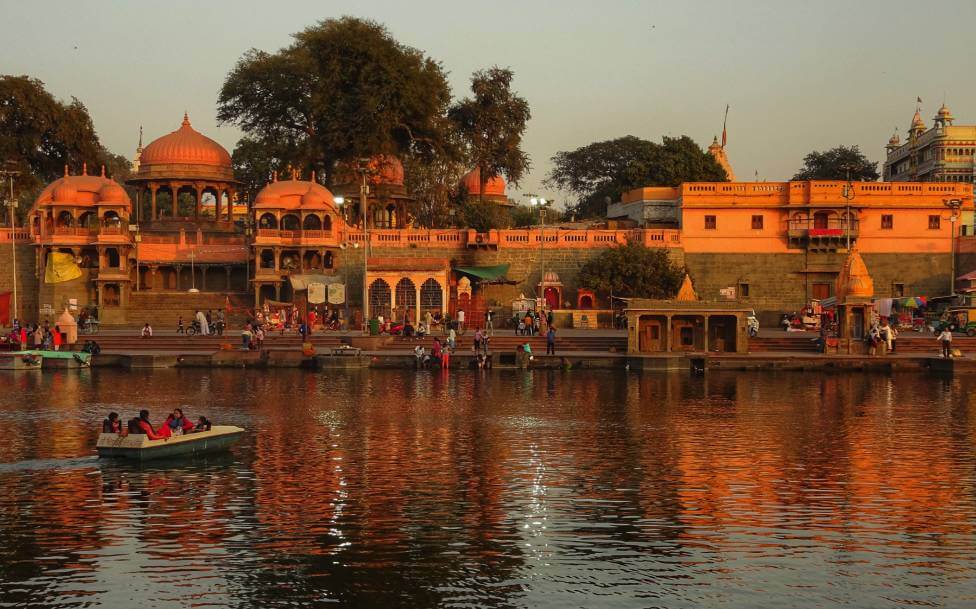
Ram Mandir Ghat is located near the Harsiddhi Temple in Ujjain and is amongst the most popular places to see in Ujjain. The ghat serves as one of the venues of the Kumbh Mela which is held every 12 years. In relation to the Kumbh celebrations, it is regarded as one of the ancient bathing Ghats. Devotees carry out their daily rituals and take a bath in the holy water here on an everyday basis. It is believed that anyone who takes a holy bath at Ram Mandir Ghat will be blessed. According to legend, Lord Vishnu split elixir over this ghat. The Chitragupta temple is the most recognised of the multiple temples that can be seen near the ghat.
Ram Mandir Ghat is an excellent area for a stroll despite its religious importance, particularly in the early morning and towards dusk. This is the location for multiple aartis that take place at dawn and in the evening. A sight to behold is the magnificent aarti and the flames’ reflection in the Ganges River’s water.
Timing: 5:30 AM to 12 PM
8. Gopal Mandir
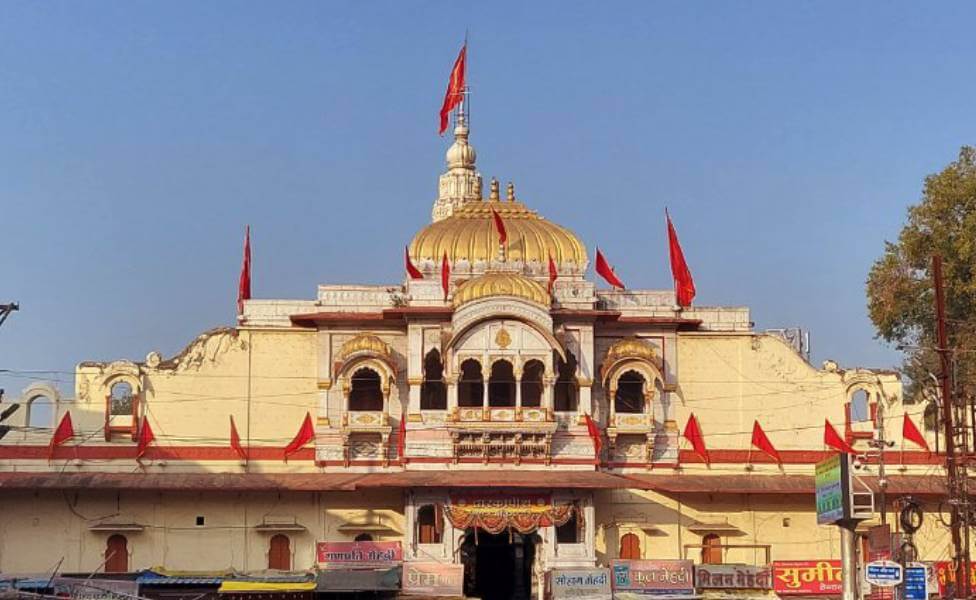
Gopal Temple at Ujjain, which is devoted to Lord Krishna, is a prime example of Maratha-style construction. The temple also has idols of Lord Shiva, Parvati, and Garuda. The masterpiece called Gopal Mandir amazes art and architecture enthusiasts who visit the temple. This must visit temple in Ujjain was built in the 19th century, by Bayajibai Shinde, the queen of Maharajah Daulat Rao Shinde. Also popular with the name Dwarkadhish Temple, Gopal Mandir is the second largest temple in Ujjain following Mahakaleshwar. Actually, it was a vintage property that belonged to Scindia estates and later on turned into a temple. According to legends, it is estimated that the Dwarkadhish Gopal Mandir is 200 years old.
The shrine is located in the middle of a big market and is a marble-spired structure with a two-foot-tall statue placed on a marble-inlaid altar with silver-plated doors and is entirely cloaked in silver and gold jewellery. The door in the temple’s inner chamber is the same door that Mahmud Ghazni took away from the Somnath temple and which Mahmud Shah Abdali, an Afghan conqueror, had brought back to Lahore. The door was found and installed in this temple by Mahadji Scindia.
At this Hindu temple, Janmashtami and Harihar Parva are celebrated with significant enthusiasm. The Harihar Parva celebration commemorates the union of Lord Krishna (Hari) and Lord Shiva (Har). At exactly midnight, Lord Mahakal visits Lord Krishna at the temple. The grand puja continues for 2 hrs.
Timing: 5:30 AM to 12 PM
9. Rumi ka Makbara
Rumi ka Makbara is a beautiful structure close to Bhartrihari Caves and is perched on top of a hill, covered from view by tall trees. Known as the tomb of Maulana Rumi, who was a Muslim, Rumi ka Maqbara or Mausoleum of Sufi Saint Rumi is one of the popular places to see in Ujjain.
The tomb is hexagonal and is five to six hundred years old. The hexagonal tomb is constructed on a 3-metre-high square pedestal. A bulbous dome sits atop the centre chamber. One enters a tunnel to reach the actual tomb directly. Some speak of Rumi as a Turkish trader while others take him to be a commander of some army unit. Indian Antiquary, Volume IV of October 1875, has published a biography including precepts of the great Sufi Saint Jelal-al-din Rumi. It is believed that Jalaluddin Mohammed Rumi, a 12th-century Sufi saint who migrated from Balkh, Afghanistan, to India, is buried here. It appears that this memorial was built in honour of his revered memory.
10. Harsiddhi Temple
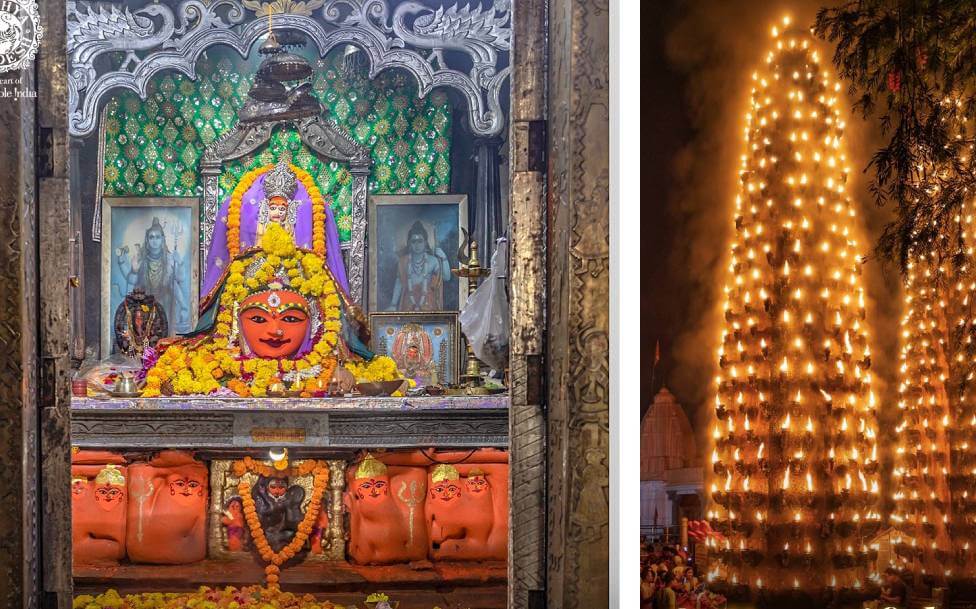
One of the Shakti peethas is the Harsiddhi Mata Temple. The Shiva Purana claims that when Shiva removed Sati’s burning body from the sacrificial fire, her elbow dropped here. There is an interesting legend in the Skanda Purana about how the Goddess Chandi acquired the epithet of Harsiddhi. Once Chand and Prachand, two demons, attempted to intrude on Mount Kailash while Shiva and Parvati were alone. Then Chandi was summoned by Shiva to destroy them away, which she accomplished. Shiva gave her the honorific title of “one who vanquishes all” out of satisfaction.
Two distinctive iron lamps stand in the shape of a pine tower-like of around 15 feet above the ground in the temple. On the land, there is an old well that has an elegant pillar adorning the top of it. The red temple, an ancient Hindu structure beyond the lamp stands symbolising the potency of Durga, is peculiar to the Maratha art of architecture. Yet another special feature of Harsiddhi temple is the Sri Yantra, or nine triangles that represent the nine names of Durga. A Yantra is a meditation tool that represents the universe. Each division of a yantra is figurative of Shakti. Also enshrined in the temple are the dark vermilion image of Annapurna, the Goddess of Nourishment, seated next to Mahasaraswati (Goddess of Wisdom and Knowledge) and Mahalaxmi (Goddess of Prosperity).
Visit the temple during Navratri celebrations to witness it in its full splendour. This site is lit by several lights and candles, which fills the visitors’ hearts with a sense of mysticism. Located close to Mahakal Temple.
Timing: 5 AM to 7 PM
11. Bhartrihari Caves
The Bhartrihari Caves, that is close to Gadkalika Temple and located just above the banks of the River Shipra, are among the most significant tourist attractions in Ujjain. Scriptures and artwork can be found in the cave. There is another small temple nearby that the Nath community visits during the pilgrimage. The location is also well-known for being the spot where King Vikramaditya’s stepbrother thought of after abandoning all ties to the belongings of the outside world.
It is said that the famous poet and scholar of antiquity, who was troubled by the infidelity of his spouse, renounced the worldly life by turning into a saint and used to spend a lot of time meditating in this cave. The name of the saint was Bhartrihari and that’s how the caves got the name. According to legend, Bhartrihari was meditating here when his spiritual abilities grew rapidly to the point where Indra, the ruler of the gods, was concerned that Bhartrihari may surpass him in strength. Indra sent a lightning bolt to destroy the cave in an effort to disrupt the concentration of the saint. Bhartrihari is recognised for using his palm to stop the cave’s ceiling from collapsing as it was about to fall. Local tour guides say that the cave’s roof still bears the imprint of his palm.
Timing: 6 AM to 9 PM
12. Chaubis Khamba Temple
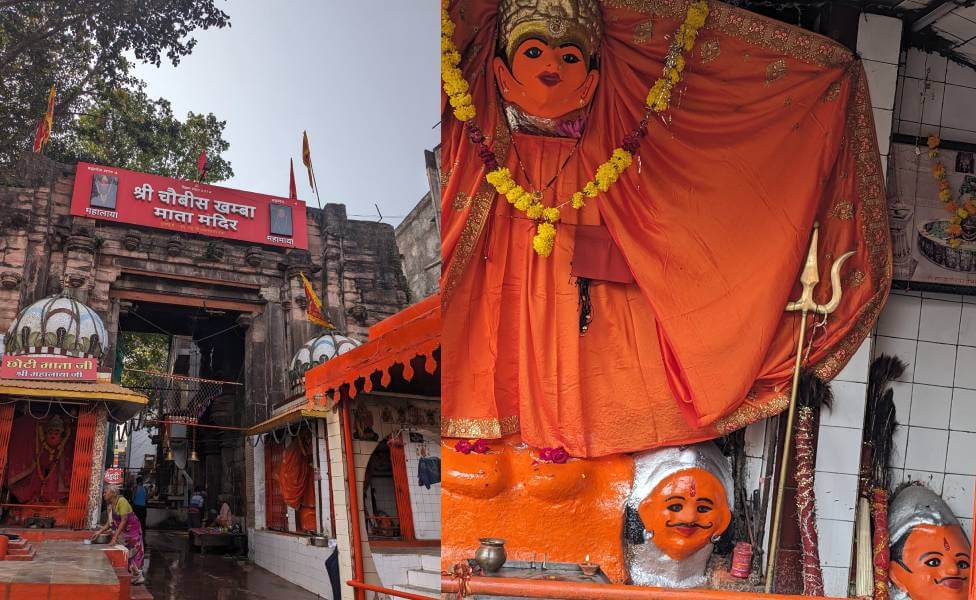
An impressive structure, Chaubis Khamba Temple is yet another best place to visit in Ujjain. The architectural design of twenty-four ornate pillars dating back to the ninth or tenth century AD by the Chandela dynasty, the temple is dedicated to Lord Shiva and also is an example of an architectural marvel.
The temple includes a square sanctum with a stunning Shiva lingam, which serves as a representation of Lord Shiva. The temple’s exterior is adorned with intricate carvings that depict scenes from Hindu mythology and people’s daily life during the mediaeval period. The carvings are regarded as some of the best works of Indian design and sculpture.
According to history, this served as the main entryway for the mighty Mahakala-towering Vana. The temple is said to be dedicated to Chhoti Mata and Badi Mata and is hailed as a holy site among the followers of Hinduism. Two splendid images of goddesses Mahalaya and Mahamaya are built on each side of the gate with the inscription of their names on the footsteps. It is an amazing piece of architecture that was constructed during the reign of King Vikramaditya. The auspicious day of Shukla Paksha Ashtami and Navratri is observed here on a huge scale that attracts a large number of devotees.
Timing: 5 AM to 7 PM
13. Gomti Kund
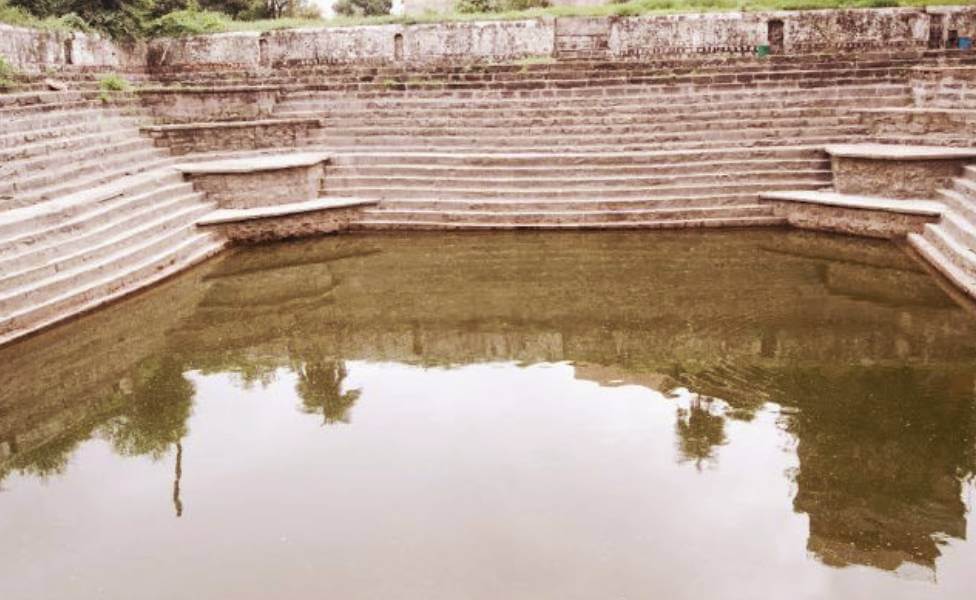
Gomti Kund is considered to be the place where Lord Krishna summoned the holy rivers from all the pilgrim centres so that his old Guru Sandipani could peacefully do all the rituals. A deep-water tank called Gomti Kund can be seen close to Sandipani Ashram. This ashram is mentioned in the Vedas and Puranas, and excavations on the site brought up painted artefacts that date back 3,000 years, establishing the site as an important location from ancient times. Excavation remnants closely resemble the artefacts discovered at Hastinapura, Indraprastha, Mathura, and Kausambi. The ashram has a temple dedicated to Lord Shiva that is a must-visit while visiting the kund. At this temple, the figure of Nandi (bull god) stands guard in front of Lord Shiva.
One of the oldest holy spots, Gomati Kund is the perennial source of water supply to the Ashram. The fact that millions of Hindus visit this sacred spot each year to experience its holy conduct demonstrates how important this kund is to their religion. Devotees fill their water bottles here and carry the water home since it is thought that the water in this pond is sacred. The Kund is also home to a lot of monkeys.
Timing: 5 AM to 6 PM
14. Kalidasa Academy
The Kalidasa Academy in Ujjain, which covers over 3374 hectares, has supported hundreds of students in connecting with Sanskrit, the first language of the world. This university translates everything from ancient Sanskrit writings to the faithful reconstruction and fabrication of Kalidasa’s poems.
The Madhya Pradesh government established the academy at Ujjain. It was created with a unique blend of intelligence and imagination by renowned architect Smt. Hema Sankalia. There are two primary reasons for opening Kalidasa Academy in Ujjain. One is to continuously remember the memory of the great dramatist-poet Kalidasa. The other is to create a multidisciplinary institution that would represent Kalidasa and the entirety of classical tradition.
At the academy, one can research in Sanskrit classical and traditional performing arts, and facilitate its adaptation in different cultural settings and language groups. The Academy complex consists of a theatre, museum, library, lecture and seminar halls, mini stage for rehearsals, research facilities for scholars, and a large open-air theatre. Here, events like the Kalidasa Festival, Nandi, and the Kalash-Yatra are celebrated in a fun-filled and lively manner. The Kalidasa Academy holds an all-India competition for traditional and folk paintings and sculptures based on Kalidasa’s works each year during the Kalidasa Festival.
Timing: 10:30 AM – 5:30 PM
15. Pir Matsyendranath
An attractive place in Ujjain, Pir Matsyendranath is situated on the bank of the River Shipra, close to the Bhartrihari Caves and the Gadkalika Temple. The structure is named after Matsyendranath, one of the most respected members of the Saivism Natha sect. Since the people of the Natha Sect and master of Guru Gorakshnath who started Hath Yoga. In addition, he is the spiritual leader of seven additional followers who, along with Gorakshnath, make up the Navnath group of nine saints. The saint’s tomb was constructed here since it is said that he attained samadhi there. Followers call their saints ‘Pir’ like the Muslims, this ancient site is venerated by both religions. It is believed that Pir Matsyendranath dates back to the 6th and 7th century BC.
Its simple white structure with a dome edged by little minarets on all sides endows a tranquil appeal to the surroundings. Tourists from across religions visit this memorial and pay their respects to the saint.
Timing: 5 AM – 7 PM
Ujjain is truly mesmerising, covered in the holy blanket of faith and devotion, this city is truly worth visiting at least once. India’s deeply ingrained culture and religious significance are on display in the tapestry of alluring places that Ujjain, a city with a rich historical and spiritual legacy, has to offer. Ujjain is a city that welcomes travellers on a special voyage of exploration and enlightenment, from the revered Mahakaleshwar Jyotirlinga to the serene Ram Ghat.
A great sense of spirituality and history can be found in Ujjain because there is a wide variety of temples, ghats, and historical landmarks. The city’s tranquil natural surroundings, palaces, and museums brilliantly complement its devotion to Lord Shiva, which is reflected in its ancient shrines. Ujjain promises visitors an amazing experience with the grandeur of Kumbh Mela, a confluence of religion and spirituality, and the serene attraction of its riverbank sites.
Please let us know if this blog helped you with sightseeing in Ujjain or in case you think that we missed a destination or two. Also if you liked this blog please don’t forget to share this blog with others. And in case Ujjain is in your mind for your next tour in India, then let us help you plan a better one.
Other Interesting Blogs to Read

 +91-9212777225
+91-9212777225 Plan Your trip
Plan Your trip